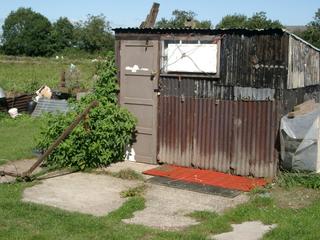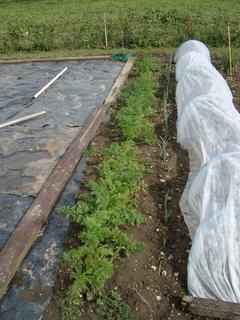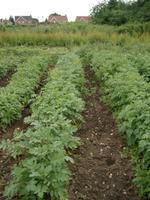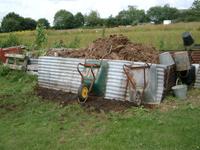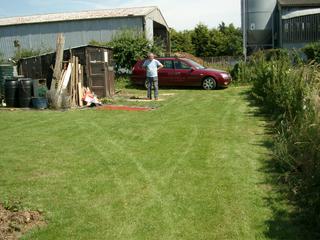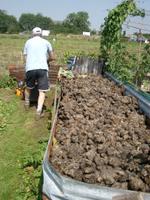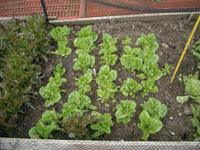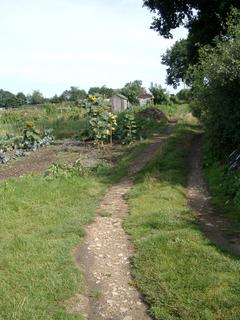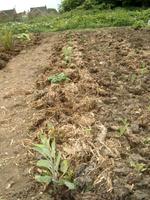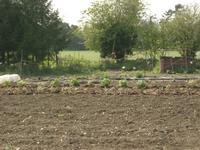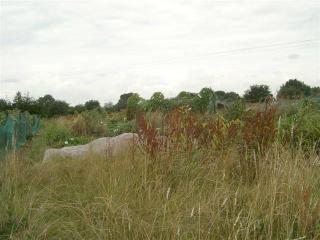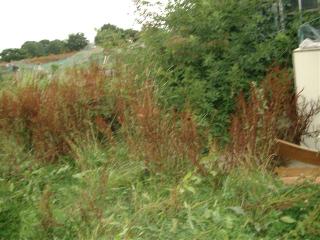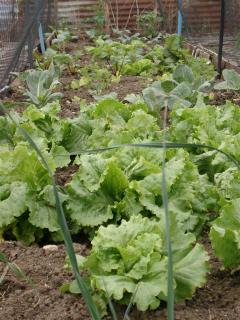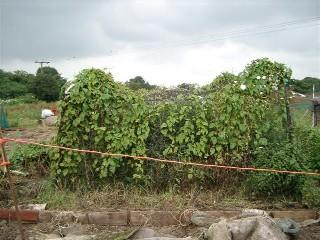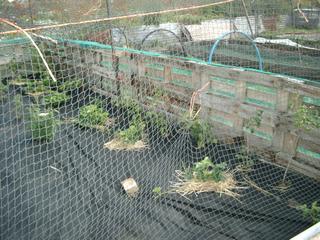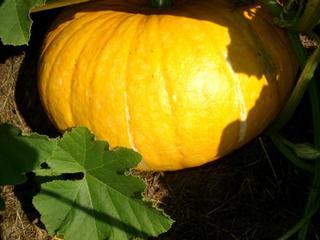2004 was to prove a year of improvisation, disappointment, realisation, ending up in jubilation. What a roller coaster of emotions – who would think that a piece of land and a few plants could cause such a combination. Boy did I have fun though, learnt a lot, ached a lot, but achieved a lot.
It seemed to me that I spent the entire year digging out dock weeds and thistles and fighting a losing battle, but like giving birth, you soon forget the agonies and reminisce about the wonderful times.
30 bare rooted summer fruiting raspberry canes – 12” pieces of unpromising dead looking sticks with straggly roots, tied up in bundles of 10. Good job I read up on how to space them. It seemed ridiculous at the time that these tiny bits of twigs should have 3ft or so of space between them – all the more room for the weeds to grow! I spent each week mulching the gaps with barrow loads of grass cuttings from four neighbours gardens – not very eco friendly taking the car up there loaded up with grass 5 times a week was it? But it helped to keep the weeds down, and the canes sprouted and grew a new stick or two each. No fruit the first year.
6 autumn fruiting raspberry canes, cuttings given to me by Sheila – who has become a dear friend with a wealth of knowledge. These grew one stem each but looked healthy.
Broad Beans – old Lenny – God rest his soul – gave me a handful of broad bean seeds that he had saved from the previous year, and which I planted to over winter Despite planting them too close together so that some of them fell over, I did get a good crop, early in the year. So I decided to do the same at the end of 2004 season, but not one took! But I was heartened by the fact that I was not alone in that failure.
Runner Beans, Climbing French Beans, Dwarf French Beans. At this stage I have to own up to getting a bit carried away at times. Having bought a packet of seed and having lots of space to grow things, I just stuck each whole packet of seeds in thinking that at least a few of them would grow – but the lot did! It was a good year for them, hence my giving carrier bags full away to everyone I came across. Boy did they taste good. I had a rainbow of colours almost, with different shades and lengths of green, yellow and purple and spotted, with all different coloured flowers before they fruited. Whoever reckons vegetable plots are dull should take a closer look.
Mange Tout and Peas – the former was a roaring success and the latter a dismal disappointment. We had good rainfall earlier when they were planted then a dry summer overall, so I guess that was why. I tried different varieties so it was not a failure of one sort.
Sweet corn – Mini and Maxi – the weather conditions must have been just right for these crops and they were a resounding success. Again we had a huge surplus and others benefited, but they looked beautiful and lush and filled up lots of room and kept the weeds down!
Onions and Shallots – a bit of a failure due to my incompetence and learning curve! By the time I was able to get on the land and dig up areas for planting – the potatoes being the top priority, it was getting a bit late to plant the onions and the sets I bought were obviously the last dregs in the shops, and were (as I know now) not good quality. After I planted them we hit the dry period so they never really got going at all, but I used the little bulbs in cooking anyway – waste not want not.
Early, Mid, and Main Crop Potatoes – after doing everything that was wrong in growing them, (apart from them being planted on soil that had not been used for years) to our total amazement they grew – and did not get blight like others on the site – did not get eaten by slugs – in fact everyone remarked how good they were. Must have been the varieties, it certainly was not my expertise at the time. But in my defence I was on my hands and knees weeding them all through the summer whereas the men just left theirs and they grew weeds taller than the potato plants too. They stored well and lasted right through the year to the start of the first new potatoes.
Salads – I grew all sorts of lettuce and salad leaves in a raised bed, and these did get nurtured – watered with rather green looking water from a tank which catches the rainfall from my little pig hut – but they seemed to like it and thrived.
Chards, Mizuna, Rocket, Red Beetroot, Sorrel, Spring Onions, Japanese Onions. These too were grown in a raised bed and all did well. As the instructions for the Japanese onions were in Japanese (a gift from my Japanese daughter in law, so too the mizuna) it was a bit hit and miss, but I put them in and they thrived. All the above were a success, and the Swiss Chards not only looked beautiful, they tasted divine in salads and cooked and lasted us to the summer of this year. They would have lasted longer but I needed to move them. The beetroot I left too long and it got as big as tennis balls and cricket balls, but I tried roasting it, and it was brilliant.
Leeks – I grew these from seed. I do not have a greenhouse so it is a bit hard growing all my seeds in pots and trays in a shed. They took a long time to grow once planted out – but maybe they do any way – and the rabbits chewed some of the green tops off them – did you know that rabbits like onions tops too? Those living around these parts eat anything! But again, waste not want not, I salvaged the crop and ate all the white bits that were underground and made leek and onions soup that I froze.
Courgettes and Pumpkins – another galloping success. It could be that I grew a lot of the courgettes, white, green, and yellow, or maybe it was the pig muck, but the ratatouille I made lasted us through the winter and was so colourful and tasty that I am doing it again this year. I only got three pumpkins plants to grow, a green one, a butternut one, and a Hokkaido (yes Japanese). Now these I did nurture despite them being 150 feet or more from the water tanks. Most of my precious water went on these, and also the grass cutting mulch. The butternut squash was a total disaster and disappointment producing two small fruit neither of which was edible. The green one produced fruit but they were hard and although yellow inside tasted dry when cooked. And yes – you can guess, the Japanese one totally exceeded everything it said it would on the packet. It said the plant would grow 10 feet, and it grew 20+ feet in all directions and climbed over three feet fences and ran along everywhere. I had to chop bits off it and put canes in to make it grow around and around. The pumpkins were delicious, and we had pumpkin soups, and I roasted and froze them as an experiment and they were thawed and warmed in the oven and used with roast potatoes, curries, stews, and mashed too. A great success.
Carrots, Parsnips, and Brassicas – I think that I left planting the carrots and parsnips a bit too late, due to the pressure of digging up weeds and clearing areas to plant everything. But we did get some small ones, and they over wintered, and despite the rabbit chewing through the netting and nibbling off the green tops and a little bit of the top of the actual carrot – yes you guessed it – waste not want not – we feasted on quite a few soups and stews from them. The spring greens and cabbage seedlings got eaten by caterpillars or slugs or maybe both – and one wise sage told me after the event that I should grow all my seedlings at home a greenhouse (which I do not have) and not in my seedbed. I just smiled sweetly and thanked them for their tips.
The Brussels sprouts were a real task of love and devotion, or sheer lunacy. After my failure with the others I was determined that these should live! A friend gave me some seedlings that he was going to throw away, and indeed told me to throw them if I didn’t want them – but oh how I did want them. They were sad looking little things, but I potted them from the seed tray into modules and watered them and when I thought they were big enough I planted them out. (Having read the book!) in rows three feet apart, and spaced three feet apart. I dug a hole a foot deep, and piled the soil all around the edge, I then dug a small hole in the bottom and planted the seedling and poured lots of water into the hole and covered it with a plastic milk container that was cut so that it was open both ends to make a sleeve. This I did thirty five times more – I saved all those little seedlings. I then put up canes and attached old CD’s to them to keep the birds away. So that sorted out the pests – or so I thought. I watered and weeded these plants religiously – I was on a mission to grow some brassicas. Once they were poking about six inches out of their sleeves I pulled the containers off them. And the pest attack began.
First came the pheasants – (have I mentioned before that we get lots of pheasants too?) They pecked at the leaves but didn’t kill them off. Then came the cabbage white butterflies so I had to do an inspection and rub off the eggs. I thought that the war was won, but from out of nowhere, they were all attacked by an army of caterpillars – in the space of a weekend when it was raining and I didn’t inspect them. The following week in a heat wave with temperatures in the high 70’s I was sitting on hard lumpy ground with a spray bottle of soapy water, spraying each single leaf of each single plant to deter or kill the caterpillars. It took me three hours each day over two days. It worked though! In December when the crop was due to be harvested, a quarter of the plants had ‘blown’ sprouts on them, due to the drought conditions I think or maybe something I did wrong. Half of the remaining crop had been attacked by pheasants eating all the lower sprouts, but I did get about a dozen plants with a good crop and froze enough to see us through right to late spring when there were other things to eat.
Tomatoes I grew a few tomato plants which produced some lovely little fruits.
I was thrilled at my first year’s crops, but I had to decide whether to tame the other half of the plot or to get someone else to work it.
2004 Crops – if you want to know the varieties get in touch.


 – and getting stung through two layers of trousers in the process! So you can imagine my utmost glee when I saw that he has got a tractor and cultivator and a huge trailer all parked down the end amongst the weeds. He has been playing with it and cultivated an area in the middle and wider across the bottom, but not along the edge. But taking an optimistic view, maybe next year he will play ‘ploughing’ every week, and will go up and down so that all the weeds keep ploughed under.
– and getting stung through two layers of trousers in the process! So you can imagine my utmost glee when I saw that he has got a tractor and cultivator and a huge trailer all parked down the end amongst the weeds. He has been playing with it and cultivated an area in the middle and wider across the bottom, but not along the edge. But taking an optimistic view, maybe next year he will play ‘ploughing’ every week, and will go up and down so that all the weeds keep ploughed under. 
